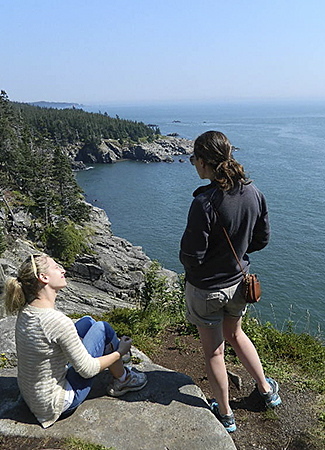MONHEGAN ISLAND — A recent Press Herald article described Protect Monhegan as a “small group” of island residents seeking the relocation of wind turbines to be placed little more than two miles from our island.
While we may be small in terms of the big institutions we are up against – Maine’s largest public university (the University of Maine), largest construction company (Cianbro Corp.) and second-largest electric utility (Emera Maine) – we represent the views of nearly half of Monhegan Island residents, as well as many other seasonal residents and visitors from around the world. Like many of us who live here, they simply can’t understand why – of all the places along Maine’s 3,500-mile coastline – the waters off Monhegan must be the place to experiment with two 585-foot wind turbines.
The fact is, the process that led to this decision has been anything but transparent. What was originally presented as a one-eighth-scale turbine, which would be tested for two five-month periods, has morphed into a 20-year-long major project, with industrial-scale wind turbines on floating towers and backed by $48 million of taxpayer money.
Legislation enabling the project was passed with little input from island residents and even less understanding of the consequences, and a 20-year term sheet was developed between the Maine Public Utilities Commission and the developers without islanders being properly represented. Despite the contention by the University of Maine that “countless” public input sessions have taken place, most of those meetings have had little or no notice, they’ve been held behind closed doors or consisted of private phone conversations, and there is no public record of what was discussed or agreed to.
In fact, the last time the university’s point person for the project was on the island, earlier this fall, his visit was unannounced and the meeting was private.
Town leaders innocently accepted no-bid contracts for various chartering jobs. In addition, some of the same people charged with communicating on behalf of islanders have received money from the developers for doing such work, creating a perceived conflict of interest, if not an actual one.
If this were taking place in almost any community on the mainland, there would be howls of protest and the news media would be all over it. But because all of this is happening on a small island 10 miles out to sea, no one seems to care that this has been such a deeply flawed process.
It is now a David vs. Goliath fight, but Monhegan is worth fighting for. Perhaps the most iconic island on the coast of Maine, it is a place that over the centuries has come to symbolize Maine’s rugged beauty and a simpler way of life.
As home to generations of fishing families and a place of inspiration to many of America’s foremost artists, Monhegan has long attracted seasonal residents and visitors looking for the kind of tranquility that only can be found on an island miles offshore – free from commercial development and the many distractions of modern life on the mainland.
Our family owns Monhegan Trucking. We greet many of the island visitors and help them transport their belongings to and from all of the island’s many rental properties. It’s clear to us why so many people from all over the world come here.
They come for birding, since Monhegan is one of the most important landfalls for migrating birds along the North Atlantic flyway. They come to hike the miles of protected trails that lead to the tallest cliffs on the Eastern Seaboard. They come to paint the island’s vistas that have been immortalized in the works of some of America’s most renowned artists. They come here to see and experience our way of life. They come here to simply rest and relax and take in the beauty and tranquility of this special place. Protect Monhegan is not opposed to offshore wind. We know that alternative forms of energy are important. We also know that there are other places along the Maine coast where this project can be located without affecting anyone’s quality of life or livelihood. In 2009, the state identified three sites as viable ocean energy test areas; the two other sites are still available.
Maine people would never allow a massive wind turbine experiment to be placed two miles from the top of Mount Katahdin or just off the shores of Acadia National Park. These are special, almost sacred places. So is Monhegan, which is why this experiment must be moved.
Send questions/comments to the editors.



Comments are no longer available on this story